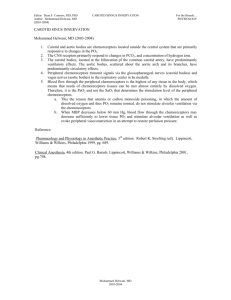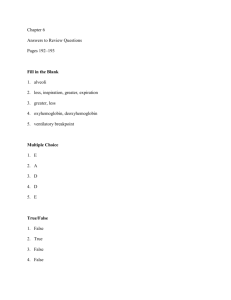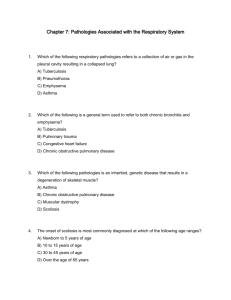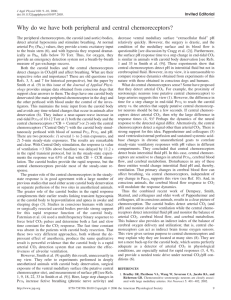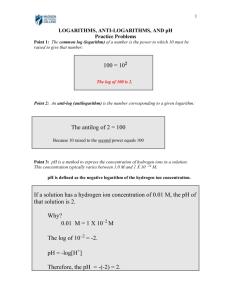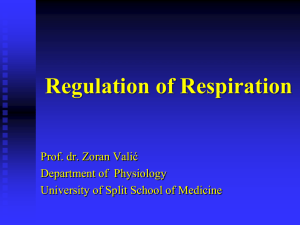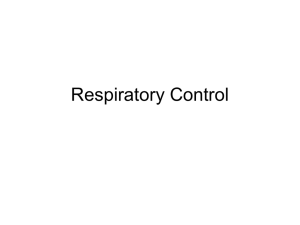Peripheral Chemoreceptors
advertisement
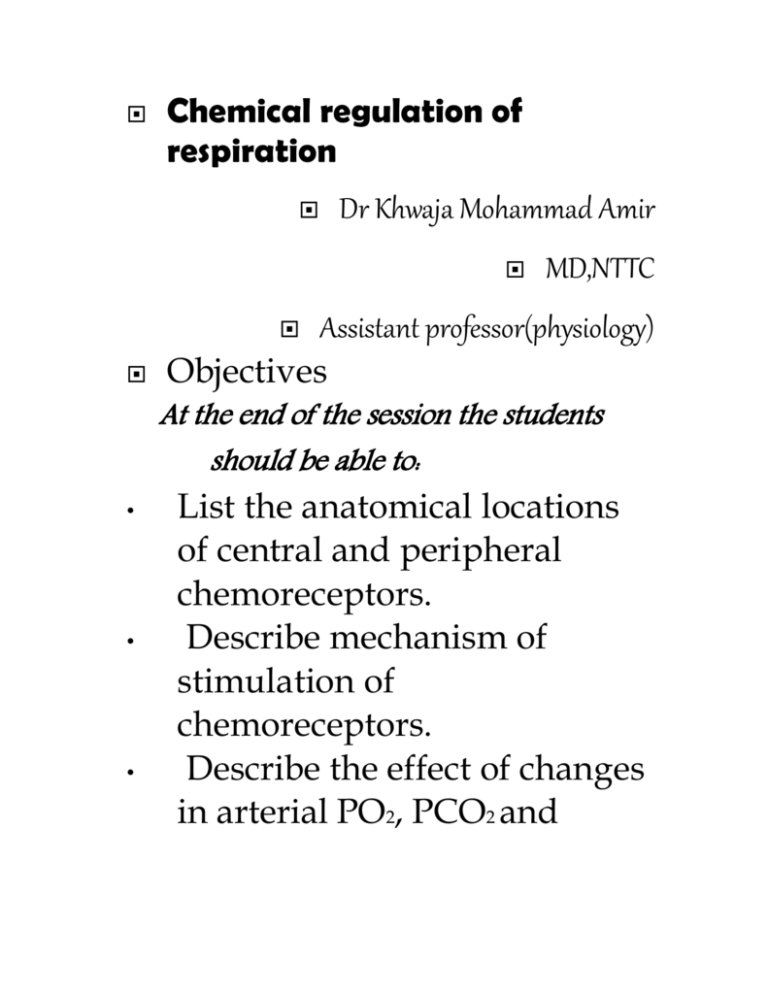
Chemical regulation of respiration Dr Khwaja Mohammad Amir MD,NTTC Assistant professor(physiology) Objectives At the end of the session the students should be able to: • • • List the anatomical locations of central and peripheral chemoreceptors. Describe mechanism of stimulation of chemoreceptors. Describe the effect of changes in arterial PO2, PCO2 and hydrogen ion concentration on alveolar ventilation. The goal of respiration is to maintain proper concentrations of oxygen, carbon dioxide and hydrogen ions in the tissues. The chemical regulatory mechanism adjusts ventilation in such a way that the alveolar pCO2 is kept constant at a normal value of 40mmHg It acts through 3 types of chemoreceptors • Peripheral chemoreceptors • Medullary (or central) chemoreceptors Pulmonary and myocardial • chemoreceptors Peripheral Chemoreceptors • These are of 2 types ― Aortic bodies: near the arch of aorta ― Carotid bodies: near the bifurcation of common carotid artery on both sides. These bodies contain two types of cells type I cells and type II cells. Type I cells contain neurotransmitter catecholamine (probably dopamine). When exposed to hypoxia they release catecholamine that stimulate the carotid body nerve(glossopharyngeal nerve) via D2 receptors. Blood flow- Carotid body-2000ml/100g/min Kidney-420ml/100g/min Heart-84ml/100g/min Hence oxygen needs of the cells of the carotid body are met largely by the dissolved oxygen alone. Peripheral chemoreceptors are especially important for detecting changes in oxygen level of the blood although to a lesser extent to carbon dioxide and hydrogen ion. The peripheral chemoreceptors are stimulated when arterial pO2decreases to as low as 6030mmHg the range in which haemoglobin saturation of oxygen decreases rapidly. Increase carbon dioxide and hydrogen ion also stimulates peripheral chemoreceptors but their effect on central chemoreceptors is much more powerful. Since effect of hypoxia on ventilation is modest for pO2 greater than 60mmHg, the pCO2 and hydrogen ion level is generally responsible for regulating ventilation in healthy humans at sea level. Peripheral chemoreceptors get stimulated by • Hypoxia • Vascular stasis • Asphyxia • Drugs (nicotine,lobeline,cyanide) • Increase in plasma potassium Medullary (Or Central) Chemoreceptors • Located on the medulla near the respiratory center but separate from it This get stimulated by the hydrogen ion concentration of the CSF and brain interstitial fluids Mechanism- carbon dioxide readily penetrates the membrane including the blood brain barrier and blood-CSF barriers, whereas hydrogen and bicarbonate ions penetrate slowly. The carbon dioxide that enters the brain and CSF is promptly hydrated to form carbonic acid which dissociates to hydrogen and bicarbonate ions .Thus local hydrogen ion concentration rises. A change in blood carbon dioxide concentration has a potent acute effect on controlling respiratory drive but a weak chronic effect after a few days of adaptation. The excitatory effect of increased carbon dioxide reduces to onefifth within 1-2 days because renal adjustment of hydrogen ion concentration in the circulatory blood towards normal. Changes in blood oxygen concentration has virtually no effect on central chemoreceptors Pulmonary and myocardial chemoreceptors • These receptors are present pulmonary and coronary blood vessels. These receptors are not active during normal physiological conditions but active only during pathological conditions like pulmonary congestion or embolism, and myocardial infarction. Injection of certain chemicals like veratridine, or nicotine into pulmonary or coronary arteries leads to apnea, bradycardia and hypotension. This reflex is called Bezold-Jarisch reflex or Coronary-chemoreflex or Pulmonary chemoreflex. Juxta-Pulmonary capillary receptors: Discovered by A.S. Paintal Also called J-receptors Located in alveolar walls in juxtaposition to the pulmonary capillaries. They are stimulated when pulmonary capillaries are engorged with blood like in pulmonary congestion or pulmonary embolism. Stimulation of this receptor produces reflex apnea followed by tachypnea, hypotension and bradycardia, this is called Jreflex. Clinical correlation • Apnea : Defined as inhibition or stoppage of respiration Causes-deglutition -after hyperventilation -Bezold-Jarisch reflex -during sleep (sleep apnea) Sleep apnea: occurs in few individuals due to depression of central chemoreceptors or failure of genioglossus muscle to contract. SIDS: Sudden Infant Death Syndrome • Breath-holding: Normal breath-holding time is 45-55 seconds. The point at which breathing can no longer be voluntarily inhibited is called the Breaking Point. It is due to increased arterial pCO2 and decreased arterial pO2. The breath holding time can be increased by • Prior breathing 100% oxygen • Prior hyperventilating room air for 1 min. • After removal of carotid bodies • Psychological-encouraging • Periodic Breathing: Defined as repeated sequence of apnea followed by respiration. • Two types: Cheyne-Stokes Respiration: Gradual sequence of apnea followed by gradual restoration of respiration. Causes-voluntary hyperventilation(physiological), heart failure, brain damage, uremia. This may lead to dizziness and tetany. Biot’s Breathing: • There are 3-4 cycles of normal respiration followed by abrupt onset of apnea and again abrupt onset of normal respiration. This cycle is repetitive. It is found in meningitis. Objectives At the end of the session the students should be able to: • • List the anatomical locations of central and peripheral chemoreceptors. Describe mechanism of stimulation of chemoreceptors. • Describe the effect of changes in arterial PO2, PCO2 and hydrogen ion concentration on alveolar ventilation.
